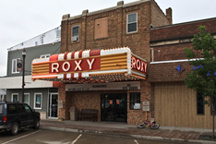 Fred R. Conrad/The New York Times |
This story in The New York Times celebrates the role of classic movie theatres in small-town America.
LANGDON, N. D. — Every Friday through Monday night, from her perch behind the Skittles and the M&M’s, Amy Freier awaits the faithful at the historic Roxy Theater. There is Dale Klein, the school bus driver (large Diet Pepsi with a refill). And there is Jeannette Schefter, the social worker (large plain popcorn, medium Diet).
“You know who comes,” said Ms. Freier, one of 200 volunteers in this town of roughly 2,000 who are keeping the Roxy’s neon glowing. “They’re part of the theater.”
In an age of streaming videos and DVDs, the small town Main Street movie theater is thriving in North Dakota, the result of a grass-roots movement to keep storefront movie houses, with their jewel-like marquees and facades of careworn utility, at the center of community life. …
The revival is not confined to North Dakota; Main Street movie houses like the Alamo in Bucksport, Me., the Luna in Clayton, N.M., and the Strand in Old Forge, N.Y., are flourishing as well. But in the Great Plains, where stop signs can be 50 miles apart and the nearest multiplex is 200 miles round trip, the town theater—one screen, one show a night, weekends only—is an anchoring force, especially for families.
It is a tradition that comes with a delicate social choreography (kids up front, teenagers in the back—away from prying parental eyes) and in spite of nature’s ferocity (subzero temperatures can freeze the coconut oil for the popcorn machine)…
It’s great to see that some small-town theatres are thriving. When we traveled cross country for four months in 1992, it was disheartening to see so many local bijous boarded up or in serious decline. And too often (for our taste), when small-town movie theatres do get restored and revived, they’re used solely as performance spaces for high school plays, community theatre, and the like.
Our favorite exception was the Washoe in Anaconda, Montana, a treasure of the theatre that is still going strong after nearly eighty years.
It’s encouraging to learn from the Times story that there’s a trend now toward preserving and restoring the original role of these theatres—showing movies. And the fact that many of these theatres are staffed by volunteers intent on preserving their treasured legacy is doubly heartening.
